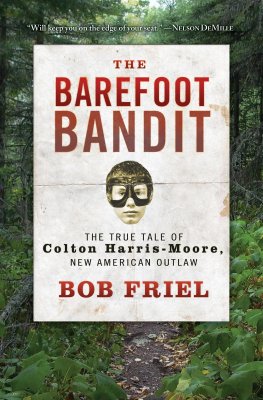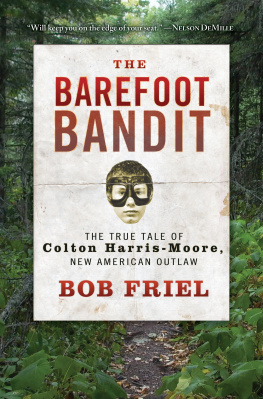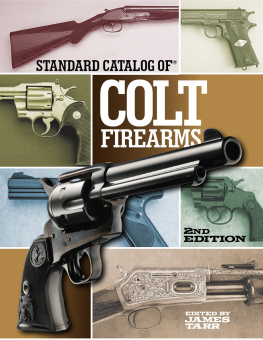Bob Friel
THE BAREFOOT BANDIT
The True Tale of Colton Harris-Moore, New American Outlaw
To great parents (especially mine), and good kids
And to all those trying to fill in the cracks

Part 1
REACH FOR THE SKY

Around 8:30 a.m. everything went to hell. Swirling 60 mph winds grabbed the little plane, shook it, rolled it, threw it down toward the jagged peaks of the Cascade mountains, then slammed it back up into the darkening skies.
The morning had started out smoothly, according to plan. After a night of lashing rains driven down the runway by gusts blowing from across the Canadian border, the predawn skies cleared and fleecy air gently blanketed Orcas Island. The barometer rose and the temperature climbed to 57 degrees, about 15 warmer than expected for a mid-November morning in the far corner of the Pacific Northwest. It looked like fine flying weatherunless youd checked the reports and saw the obvious shitstorm coming.
Pilots of small aircraft obsess about the weather. Ill winds, icing, poor visibilityall can bring your flight to a terminal, smoldering conclusion. Before the FAA considers a pilot minimally safe to solo, he must study and train intensively, racking up forty or more hours of air time sitting alongside a calm, cool flight instructor ready to instantly take over and recover from blunders that could otherwise kill them both. During ground school, student pilots learn the one surefire way to avoid trouble with dangerous weather: dont fly in it. However, when youre a seventeen-year-old with zero hours of official flight training strapped into a stolen airplane trying to make a quick getaway from a whole lotta law enforcement on your tail Well, you have other things on your mind besides the weather forecast.
As the sky began to glow, teasing misty details from the islands steep, evergreen hillsides, the teen had busied himself with final preflight preparations inside one of Orcas airports private hangars. More than seventy small aircraft bed down on the island, and its single runway averages nearly 150 takeoffs and landings per day. You can watch the airplane action from the parking lot, the adjacent dog park, a spot just north called Smugglers, or from the woods behind the airports flimsy deer fence. You can also spy on the comings and goings from Orcas Islands small sheriff stationknown to locals as the cop shopthat lies within badge-tossing range of the runways south end.
A few days earlier, one of the landings was made by a 1999 Cessna 182 Skylane, tail number N24658. The would-be thief recognized that model on sight, just as he knew every Cessna, Piper, Beech, Cirrus, and other small plane. Regardless of its challenges with impulse control and social norms, the kids brain functioned as an aircraft encyclopedia crammed with engine ratings, performance stats, and avionics capabilities. Flying had been his one constant dream, one soaring aspiration in an otherwise bottom-of-the-barrel life, and hed been teaching himself about flight since childhood, obsessively paging through airplane books until their bindings disintegrated. Now, at an age when most kids spent all their feverish energy trying to wangle a sweaty hour or two with another teen in a backseat or on a basement couch, Colton Harris-Moores one overwhelming desire was to spend illicit time in the privacy of a hangar with a plane he planned to make his own.
This particular Cessna, he knew, offered fuel-injected reliability and a rugged, easy-to-fly airframe. It was an airborne SUV, the Ford Bronco of the skies, and he could close his eyes, project an image of the cockpit, and reach out to virtually touch every control, switch, and gauge.
The Cessna had landed, rolled out, and taxied to its home in the airports hangar farm. Other planes slept under the stars, tied down out on the tarmac, but Colton wanted one stored out of sight. After sundownafter the daily FedEx flight and the last of the commuter runs had taken off for Seattle and Bellingham, and the airports provincial terminal went dark for the nighthe simply walked through the open fence.
A typical small-plane hangar features a large door for the aircraft along with one or more regular-size entrances called man doors. Plane theft is practically unheard of and few private hangars have alarm systems despite housing planes worth hundreds of thousands or millions of dollars. It took just a few seconds to jimmy open the man door. Inside, Colton switched on his headlamp and illuminated his dream.
FLIERS LOVE THEIR AIRPLANES. Passionately. During preflight inspection, a pilot caresses the frame. He runs his hands along the ships smooth skin, probing her flaps, stroking every inch of her propeller blades, even gently lifting her tail. It seems to go well beyond a simple safety check.
An intimate relationship with an airplane offers its pilot superhuman ability, harnessing simple physics to magical effect. Pull back on the yoke and zoom to ten thousand feet, laughing in the oppressive face of gravity that back on earth remains ready to ruin you just for tripping on the stairs or leaning too far back on a bar stool. For aficionados, planes elicit fanatical devotion.
As Colton scanned the inside of the hangar, he saw the Cessna owners face watching his every move. The plane belonged to Bob Rivers, a popular radio personality who lived down in Seattle and lived for flying his plane up to the San Juan Islands on the weekends. Promotion posters featuring Riverss smiling, silver-maned mug decorated the hangar walls.
The idea that Rivers owned and flew a small plane had been the subject of much banter on his morning radio show. Hed first had to overcome a deathly medicate me and wake me when its over fear of flying. Pilot friends and the interminable lines for the ferries heading out to the San Juans during the summer tourist season finally convinced him to reconsider the power of flight. Now he loved it, and especially loved his immaculately kept $175,000 Cessna Skylane.
Colton foraged around the hangar until he found the planes key inside a tackle box sitting amid a pile of stored boating gear. He climbed inside the cockpit, powered up the gauges, and saw that the tanks held enough fuel. As he expected, the Skylanes POH sat inside the plane. The Pilots Operating Handbook is a detailed manual specific to every aircraft, and includes step-by-step checklists for prepping, starting, taking off, flying, and landing. Its the planes Rosetta Stone.
Colton had all night to pore over the POH as well as manuals for the avionics, radio, autopilot, and GPS navigation equipment. Out of the small flock of Cessnas roosting at Orcas airport, Riverss was the only one outfitted with a Garmin MX200, an $8,000 add-on GPS situational awareness system that makes navigating similar to a video game. One of these modern GPS chartplotters linked to a planes mechanical and autopilot systems simplifies much of the fliers in-flight calculations and workload. Click a cursor anywhere on the chart and the computer instantly tells a pilot how to get to his destination. It wont get a plane up in the air, though.
Airplanes want to fly. Pick the right one, like the Skylanenot too complicated, not too powerful, stable high-wing design, built to operate at relatively slow speedsthen meticulously follow the POH checklists, and theres a very good chance that even without taking a single flight class, you could get it up in the air. Then, however, youre royally screwed.












